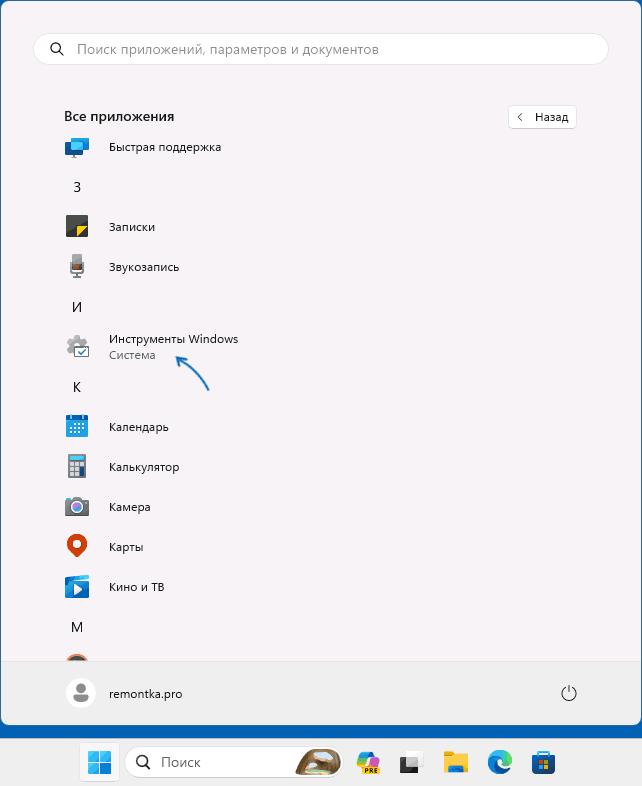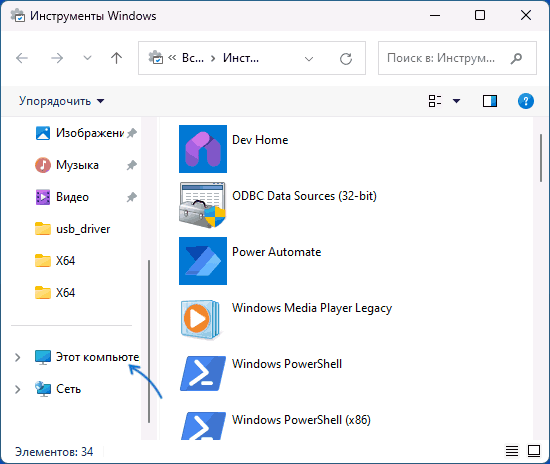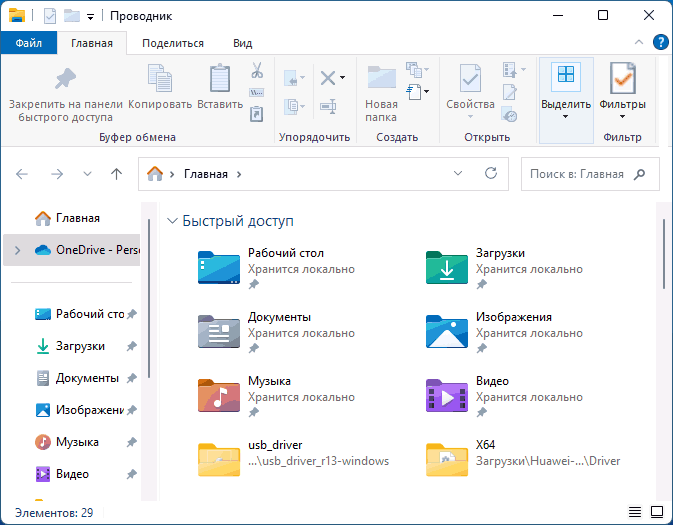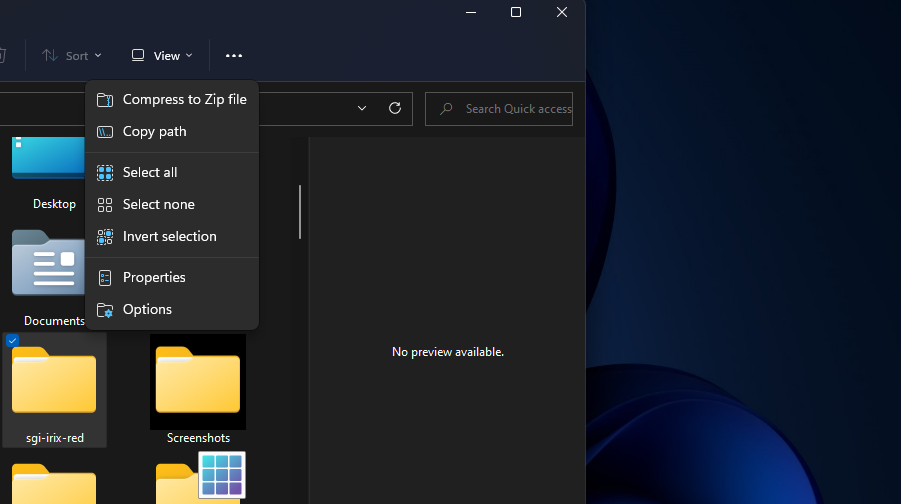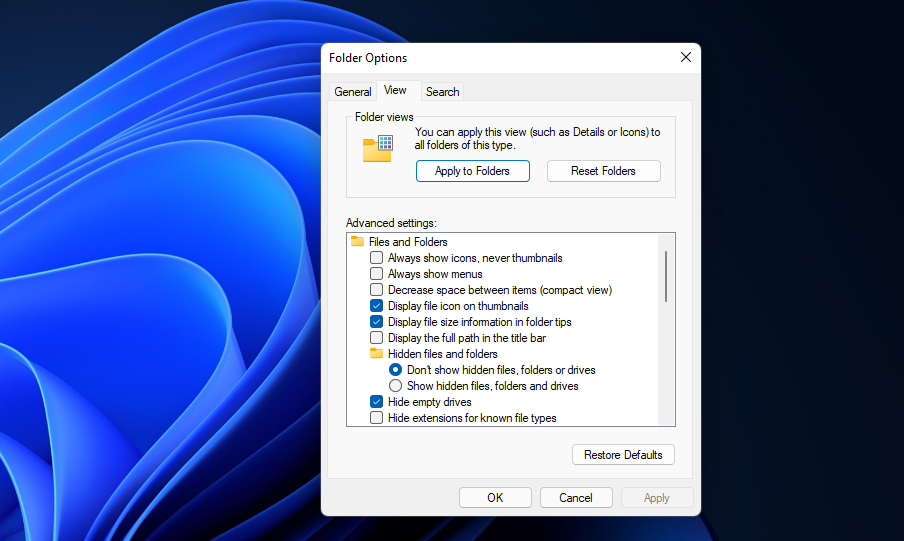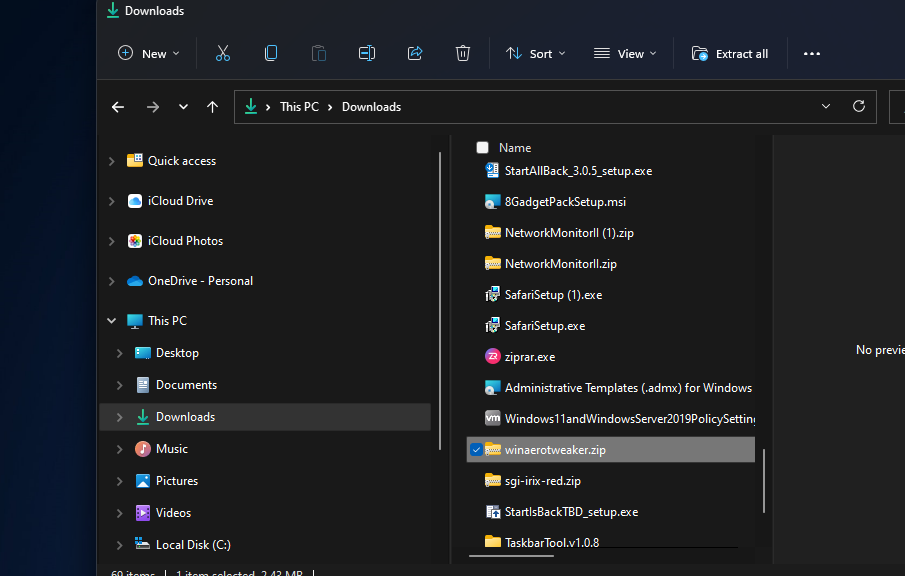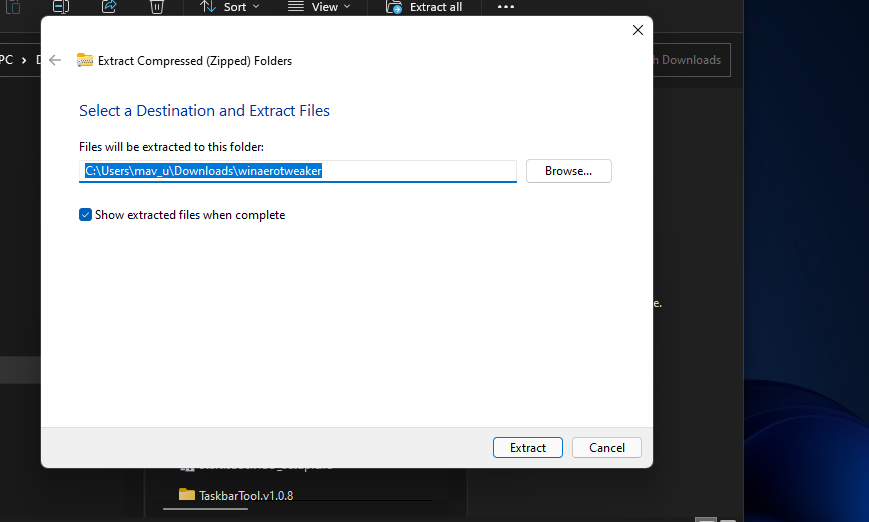Среди прочих нововведений Windows 11 — видоизмененный «Проводник», который некоторым пользователям пришелся не по душе. При желании вы можете использовать и классический вариант Проводника.
В этой инструкции подробно о способах открыть старый проводник в Windows 11 как средствами системы, так и с помощью сторонних инструментов.
Классический Проводник всё ещё есть в Windows 11 и его можно запустить прямо в системе, но для этого придётся выполнить несколько шагов:
- В меню «Пуск» — «Все приложения» или в «Панели управления» откройте пункт «Инструменты Windows».
- В открывшемся окне «Инструменты Windows» откройте «Этот компьютер» в панели слева.
- Будет открыт Проводник, причем е его старом виде.
Неизвестно, сколько ещё проработает этот способ (предполагаю, что это не было задумано разработчиками), но в Windows 11 23H2 он функционирует.
К сожалению, способ имеет свои ограничения: необходимо каждый раз заходить в «Инструменты Windows», либо создать ярлык для них в удобном месте. Если же сделать ярлык для пункта «Этот компьютер» из указанного расположения, будет открываться уже новый проводник Windows 11.
ExplorerPatcher
Вторая возможность — использовать стороннее приложение для настройки вида элементов Windows 11 ExplorerPatcher. Шаги будут следующими:
- Скачайте последнюю версию ExplorerPatcher с GitHub https://github.com/valinet/ExplorerPatcher/releases
- Запустите загруженный файл: на некоторое время экран может стать чёрным, это нормально, также вид панели задач изменится (его можно будет вернуть).
- Нажмите правой кнопкой по панели задач и выберите пункт «Свойства».
- Если требуется вернуть прежний вид панели задач, на вкладке «Taskbar» установите стиль Windows 11, а затем нажмите «Restart File Explorer».
- Перейдите в раздел «File Explorer» и отметьте пункт «Use classic drive groupings in This PC», а ниже установите Windows 10 Ribbon в поле «Control Interface». Включите пункты «Disable the Windows 11 context menu», «Use immersive menus when displaying Windows 10 context menu», «Disable modern search bar». После этого нажмите «Restart File Explorer» внизу слева.
- Теперь, если вы запустите Проводник он будет открыт в своём старом виде:
Ключевым для настройки является включение «Windows 10 Ribbon», но без настроек остальных пунктов, например, отключения новых контекстным меню Windows 11, классический «Проводник» может закрываться с ошибками.
Учитывайте, что при выходе новых обновлений Windows 11 часть функций ExplorerPatcher могут перестать работать, такое уже случалось. А для удаления программы и сделанных ею настроек используйте «Программы и компоненты» в Панели управления.
В ранних версиях Windows 11 существовал ещё один вариант включения старого проводника: в разделе реестра
HKEY_LOCAL_MACHINE\SOFTWARE\Microsoft\Windows\CurrentVersion\Shell Extensions\Blocked
можно было создать строковый параметр
{e2bf9676-5f8f-435c-97eb-11607a5bedf7}
и перезагрузить компьютер, однако в текущих версиях системы этот способ не работает.
How to Set Up File Explorer in Windows 11
Windows 11 introduces a new look and feel, emphasizing productivity and user experience. One of the critical components of the operating system is File Explorer, which serves as your gateway to file management on your device. Whether you’re navigating through documents, images, or system files, organizing and optimizing File Explorer is essential for an efficient workflow. This guide will walk you through the steps to set up and personalize File Explorer in Windows 11, ensuring that you make the most out of the modern interface.
Understanding the New Look and Features of File Explorer
Before diving into the setup process, it’s important to familiarize yourself with the features and layout of File Explorer in Windows 11.
1. Updated Interface
The Windows 11 File Explorer sports a sleek and modern design that emphasizes simplicity and functionality. The navigation pane (located on the left side) gives you quick access to essential folders, including Quick Access, OneDrive, and This PC. The top menu ribbon has been streamlined, featuring key actions like ‘New’, ‘Copy’, ‘Paste’, and ‘Delete’. Users will notice a minimalistic approach with a centered Command Bar that takes precedence over previous versions’ command areas.
2. Integrated Search
The integrated search function is more powerful in Windows 11. It allows you to find files quickly, and the filter options make it easier to drill down into your results by file type, size, and date modified.
3. Quick Access
Quick Access lets you pin frequently used files and folders for easy retrieval. This feature is particularly useful for users who work on multiple projects and need to switch between folders frequently.
4. Preview Pane
Viewing files without opening them is a huge time-saver. The Preview Pane lets you quickly glance at the content of files, such as images, documents, and videos, improving your workflow.
5. Contextual File Operations
Right-clicking on files and folders will bring up a context menu that is both familiar and efficient, offering key actions related to the selected item.
Setting Up File Explorer in Windows 11
Step 1: Opening File Explorer
To begin setup, open File Explorer. You can do this in several ways:
- Click the File Explorer icon on the Taskbar.
- Press Windows Key + E on your keyboard.
- Right-click the Start button and select File Explorer.
Upon opening, you’ll see the new layout, allowing you to navigate through various sections of your computer.
Step 2: Customizing the Navigation Pane
The navigation pane on the left is your main hub for accessing folders and drives. Here’s how to tailor it to fit your preferences:
-
Pinning Folders to Quick Access:
- Navigate to any folder you want to pin.
- Right-click on the folder and select Pin to Quick Access. This will allow easy retrieval from the left pane.
-
Removing Unwanted Items:
- If Quick Access has items you no longer use, right-click on them and select Unpin from Quick Access.
-
Expand and Collapse Folders:
- You can expand or collapse drives and folders by clicking the small arrow next to them, providing a cleaner, less cluttered look.
Step 3: Customizing the Main Window Layout
Now that you’ve organized the navigation pane, let’s customize the main window layout:
-
Changing the View:
- Click on the View menu in the Command Bar.
- Choose from options like Details, List, Icons, or Content to suit how you prefer to view your files.
-
Sorting Files:
- In the ‘Details’ view, files can be sorted by name, date modified, type, size, etc. Click on the column header to toggle between ascending and descending order.
-
Grouping Files:
- To group your files, right-click in an empty area of the main window, select Group by, and choose an option that suits your workflow.
Step 4: Using Tabs in File Explorer
The tabbed interface is a powerful functionality in Windows 11. You can open multiple File Explorer windows in one instance:
-
Opening a New Tab:
- Click on the + icon next to the open tabs at the top of the window or to the right of an open tab to add a new tab.
-
Switching Between Tabs:
- Click on any tab to switch between them seamlessly, much like you would in a web browser.
-
Closing Tabs:
- Close a tab by clicking the X icon on the tab itself.
Step 5: Using the Search Function
File Explorer’s search functionality is more integrated than ever. Here’s how to use it effectively:
-
Performing a Basic Search:
- Click in the search bar located at the top right of the File Explorer window, then start typing what you’re looking for.
-
Utilizing Search Filters:
- After performing a search, use filters available in the menu that appears just below the search bar. You can filter by date, file type, and other parameters for a more refined search results list.
-
Saving Searches:
- If you frequently search for the same items, consider saving your search by clicking on the Search tab and selecting Save Search.
Step 6: Exploring the Preview Pane
The Preview Pane is a handy feature for quickly viewing files:
-
Enabling the Preview Pane:
- Go to the View menu and select Show followed by Preview pane.
-
Previewing Files:
- Click any file in your File Explorer to see its contents appear in the Preview Pane without needing to double-click to open it.
Step 7: Organizing Your Files and Folders
A well-organized file structure can significantly enhance your productivity:
-
Creating Folders:
- In any directory, right-click in an open area and select New > Folder. Name it appropriately to keep your files categorized.
-
Moving Files:
- Select the files you want to move, then either drag them to the desired folder or right-click and select Cut, then navigate to the folder you want to move them to, right-click, and select Paste.
-
Renaming Files:
- To rename a file, right-click on it and select Rename, or click on the file once and press F2 to edit the filename.
Step 8: Personalizing Folder Backgrounds and Icons
To make your File Explorer experience more visually appealing, consider personalizing folder backgrounds and icons:
-
Changing Folder Icons:
- Right-click on a folder and select Properties, navigate to the Customize tab, and click on Change Icon to select a new icon.
-
Using Custom Wallpaper:
- There are third-party applications available that allow you to customize folder backgrounds, giving your folders a unique visual flair.
Step 9: Utilizing OneDrive Integration
Windows 11 promotes the use of OneDrive for file storage and synchronization:
-
Accessing OneDrive:
- You will find OneDrive in the navigation pane by default if you have set up and signed into your Microsoft account.
-
Uploading Files:
- Drag and drop files into the OneDrive section or right-click on files and select Move to to upload to your OneDrive.
-
Managing Sync Settings:
- Right-click on the OneDrive cloud icon in the Taskbar, select Settings, and configure how and when your files will synchronize.
Step 10: Customizing File Explorer’s Settings
Make further adjustments to optimize your File Explorer experience:
-
Accessing Folder Options:
- Click on the three-dot Menu (the ellipsis) in the Command Bar and choose Options from the dropdown list.
-
Changing View Settings:
- Under the View tab, choose whether you want to show hidden files, folders, and drives, and you can also choose to always open folders in a separate window.
-
Resetting Folder Views:
- If you ever want to revert to default view settings for all folders, you can change them in the View tab and click on Apply to Folders.
Step 11: Keyboard Shortcuts for Efficiency
Familiarizing yourself with keyboard shortcuts can greatly speed up your navigation and management in File Explorer:
- Ctrl + N: Open a new File Explorer window.
- Ctrl + W: Close the current window.
- Ctrl + Shift + N: Create a new folder.
- Alt + Enter: Open the properties for the selected file/folder.
- F2: Rename the selected item.
- Ctrl + C: Copy selected items.
- Ctrl + V: Paste copied items.
Step 12: Maintaining File Explorer’s Performance
To ensure that File Explorer continues to perform well, it’s crucial to maintain optimal conditions:
- Delete Unnecessary Files: Regularly clear out files that you no longer need.
- Empty the Recycle Bin: Periodically empty the Recycle Bin to free up space.
- Use Disk Cleanup: Utilize the built-in Disk Cleanup tool to clear temporary files and system cached data.
Step 13: Trouble Shooting Common Issues
Here are some common File Explorer issues and tips on how to resolve them:
-
File Explorer Not Responding: If File Explorer freezes or is unresponsive, you can restart it via the Task Manager. Press Ctrl + Shift + Esc, find Windows Explorer in the list, right-click, and select Restart.
-
Search Function Not Working: If you find that search isn’t functioning correctly, try rebuilding the search index by going to Control Panel > Indexing Options > Advanced > Rebuild.
-
File Explorer Crashes: This may be due to corrupted system files. Use the System File Checker tool by running the command sfc /scannow in the Command Prompt with Administrator privileges.
Conclusion
Setting up and personalizing File Explorer in Windows 11 can significantly enhance your experience and productivity. The modern interface, coupled with powerful features, allows users to manage files intuitively. By following the steps outlined above, you can ensure that File Explorer suits your workflow needs, from organizing files efficiently to utilizing powerful search and preview functionalities.
Take the time to explore the many aspects of File Explorer and make adjustments that will benefit your specific use-case. As you become more accustomed to this updated file management system, you’ll find that your efficiency increases and your digital workspace feels more organized and accessible. Remember, a well-configured File Explorer is a key asset in navigating the complexities of file management.
Новый вид проводника может понравиться не каждому пользователю. Кому-то новый вид Проводника может быть неудобным. Поэтому Microsoft оставила возможность вернуть классический вариант.
Нажмите Windows + R, чтобы запустить приложение Выполнить. Или нажмите на кнопку Пуск и начните писать Выполнить, после чего нажмите на приложение.
В появившемся окне напишите regedit и нажмите кнопку ОК.
Перейдите по следующему пути в редакторе реестра: HKEY_LOCAL_MACHINE\SOFTWARE\Microsoft\Windows\CurrentVersion\Shell Extensions
Щелкните правой кнопкой мыши по папке Shell Extensions, затем выберите Создать и выберите Раздел.
Назовите раздел Blocked и нажмите на него левой кнопкой мышки.
Щелкните правой кнопкой мышки в пустое место, выберите Создать и выберите Строковый параметр.
Введите это значение: {e2bf9676-5f8f-435c-97eb-11607a5bedf7} и нажмите Enter.
Перезагрузите компьютер
После перезагрузки изменения вступят в силу.
Проводник в Windows 11 до и после изменения
Если вы передумали и хотите вернуть проводник Windows 11, то вам нужно вернуться в редактор реестра и удалить созданный параметр {e2bf9676-5f8f-435c-97eb-11607a5bedf7}.
Неочевидные функции, которые сделают работу с файлами удобнее.
1. Множественный выбор файлов
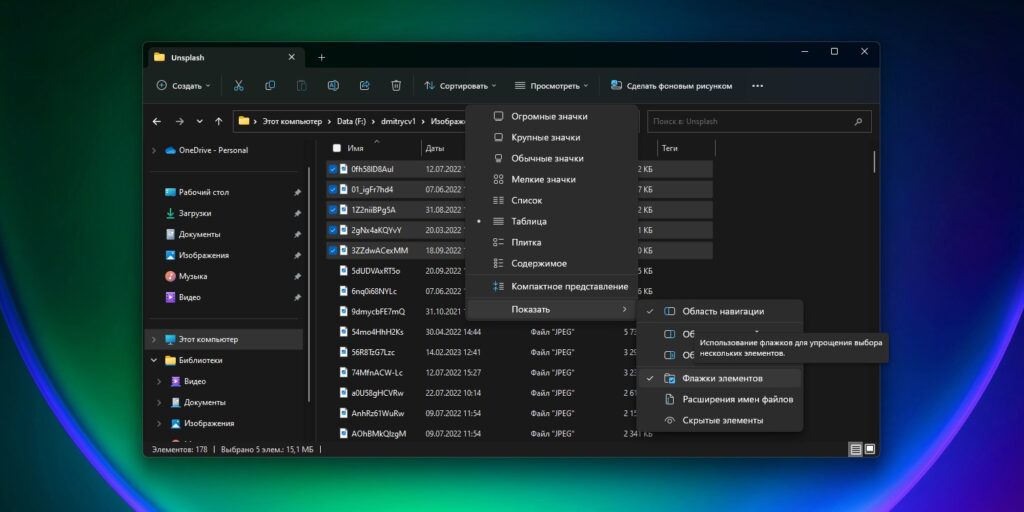
В Windows есть много способов быстро выбрать несколько файлов. Например, удерживая кнопку Ctrl, указать нужные документы. Также можно выбрать диапазон файлов: удерживая Shift, щёлкнуть первый и последний документ или папку в списке. Наконец, можно выделить все документы сразу, нажав Ctrl + A.
Но существует и менее очевидный способ — флажки в «Проводнике». Откройте его и выберите «Просмотреть» → «Показать» → «Флажки элементов». После этого наведите курсор на файл. Рядом появится флажок, и вы сможете выбрать несколько документов, отметив чекбоксы рядом с ними.
2. Перемещение «Корзины»
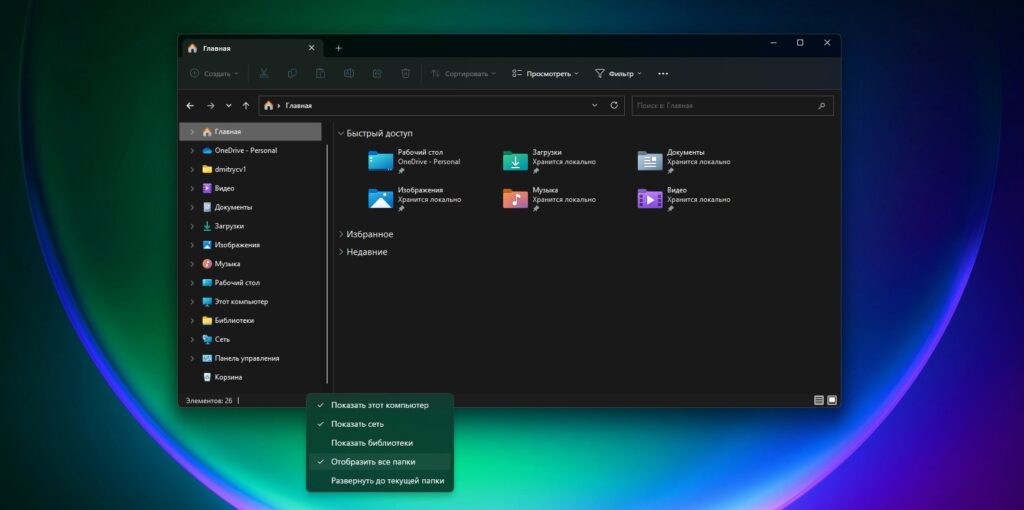
Обычно в Windows «Корзина» располагается на рабочем столе. Это неудобно, потому что для доступа к ней каждый раз необходимо закрыть или свернуть все окна.
Вместо этого вы можете добавить «Корзину» на боковую панель навигации «Проводника». Там вы сможете открыть ее или просто перетащить в неё документы и папки прямо из окна файлового менеджера, что, согласитесь, куда удобнее.
Есть два способа добавить «Корзину» в «Проводник». Первый: перетащите её на панель быстрого доступа — туда, где находятся ваши папки. И она останется там.
Второй вариант: щёлкните правой кнопкой мыши по пустому месте на панели «Проводника» и выберите опцию «Отобразить все папки». После этого вы увидите, что «Корзина» появилась среди элементов.
3. Настройка компактного вида
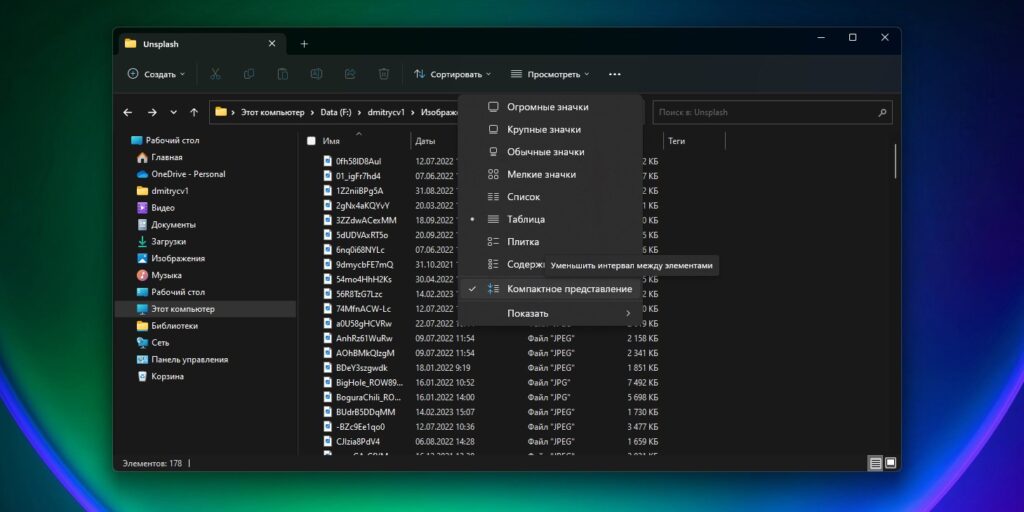
Если вам кажется, что между файлами в вашем «Проводнике» многовато свободного места, это можно исправить, включив компактный вид. Нажмите «Просмотреть» и выберите опцию «Компактное представление».
Лишнее пространство между файлами исчезнет, и они будут располагаться ближе друг к другу. Это полезно на небольших экранах, например на планшетах и 13‑дюймовых ноутбуках. Имейте в виду, что компактный вид работает только в случае, если папки у вас отображаются в виде списка или таблицы.
4. Скрытие недавних папок и файлов
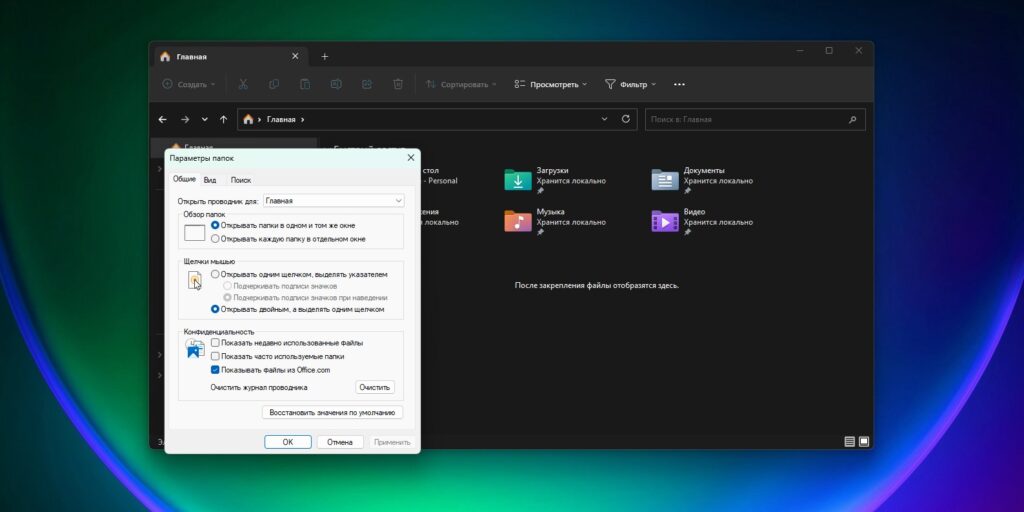
Если вам кажется, что область быстрого доступа в «Проводнике» загружена ненужными файлами и папками, вы можете скрыть последние использованные элементы.
Для этого нажмите на три точки на верхней панели «Проводника» и выберите «Параметры». В появившемся окне снимите флажки с опций «Показать недавно использованные файлы» и «Показывать часто используемые папки в быстром доступе». Нажмите кнопку ОК, чтобы сохранить изменения.
Теперь последние использованные файлы и папки не будут отображаться в разделе быстрого доступа. И в этом есть несомненный плюс: никто из посторонних не сможет в ваше отсутствие увидеть, с какими документами вы работали.
5. Добавление папок на панель навигации
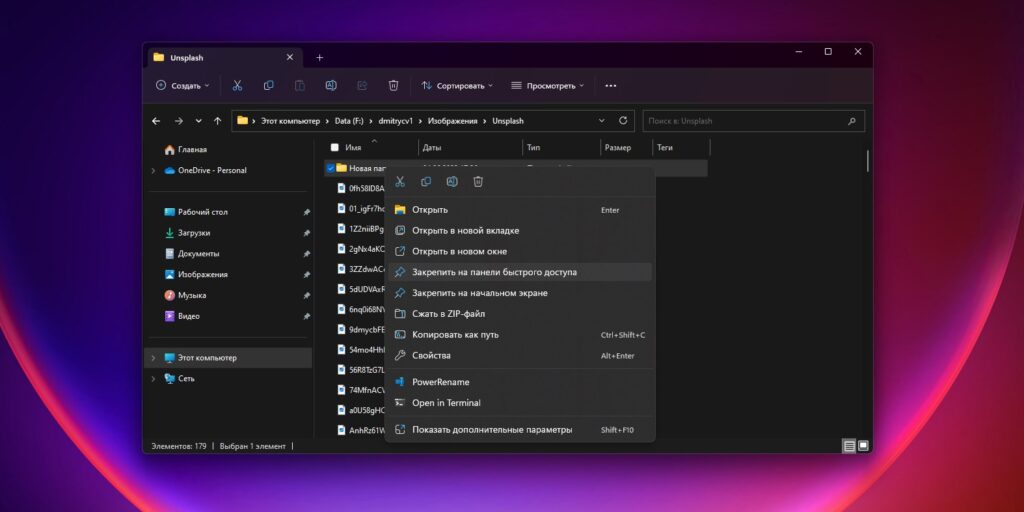
По умолчанию на панели «Проводника» закреплены стандартные «Документы», «Музыка» и прочие варианты. Но вы можете закинуть туда и собственные папки, чтобы всё время иметь к ним доступ.
Щёлкните правой кнопкой мыши по папке, которую вы хотите закрепить в «Проводнике». В появившемся контекстном меню выберите опцию «Закрепить на панели быстрого доступа».
Теперь выбранная папка будет всегда отображаться на панели сбоку. Кроме того, вы можете закреплять папки, просто перетаскивая их на панель мышью.
Если же вам нужно открепить папку, щёлкните по ней правой кнопкой и выберите «Удалить из панели быстрого доступа».
6. Добавление «Библиотеки» на панель навигации
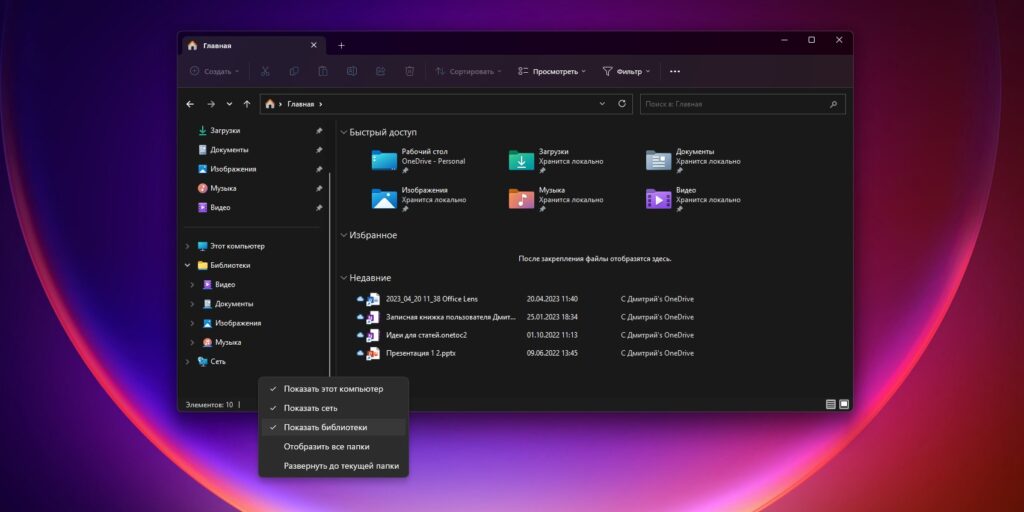
«Библиотеки» в Windows — это набор ваших основных папок, таких как «Документы», «Музыка», «Изображения» и «Видео». Чтобы добавить её на панель навигации в «Проводнике», щёлкните правой кнопкой мыши в любом пустом месте на левой панели и в контекстном меню выберите опцию «Показать библиотеки».
После этого папка «Библиотеки» будет добавлена на панель навигации, что позволит вам быстро получить доступ к вашим каталогам.
7. Массовое переименование файлов
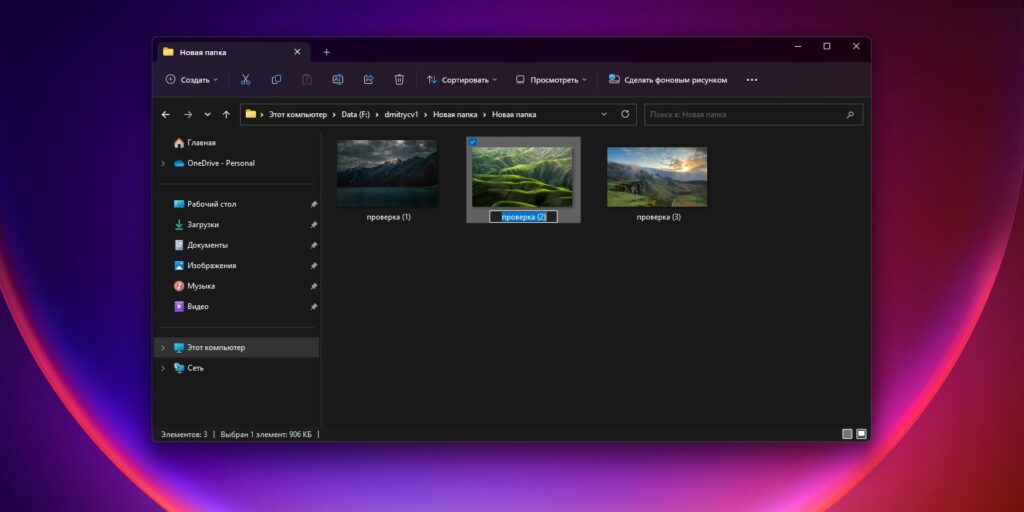
Массовое переименование файлов может быть утомительной задачей, особенно если их у вас много. Обычно для этого приходится щёлкать каждый документ правой кнопкой мыши, выбирать опцию «Переименовать», вводить новое имя и нажимать клавишу «Enter».
Однако есть более простой способ. Вместо нажатия клавиши «Enter» после переименования файла можно нажать клавишу «Tab». Это позволит выделить следующий документ и сразу перейти к его названию.
8. Поворот изображений
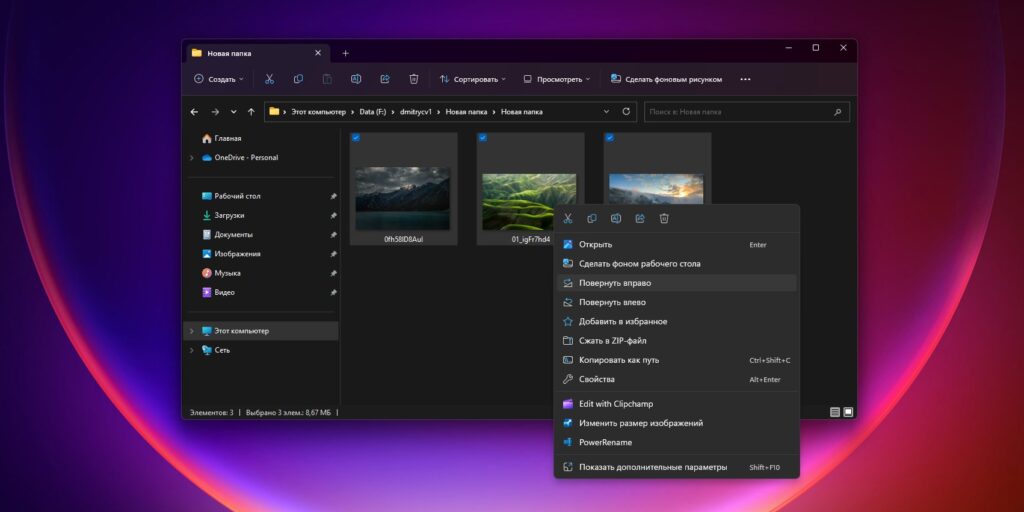
Если вам необходимо повернуть несколько изображений одновременно, есть удобный способ сделать это. Просто выделите все нужные картинки, зажав клавишу Shift или Ctrl, затем щелкните правой кнопкой мыши по одному из них и выберите «Повернуть влево» или «Повернуть вправо». И никакой утомительной ручной работы.
9. Изменение изображения папки
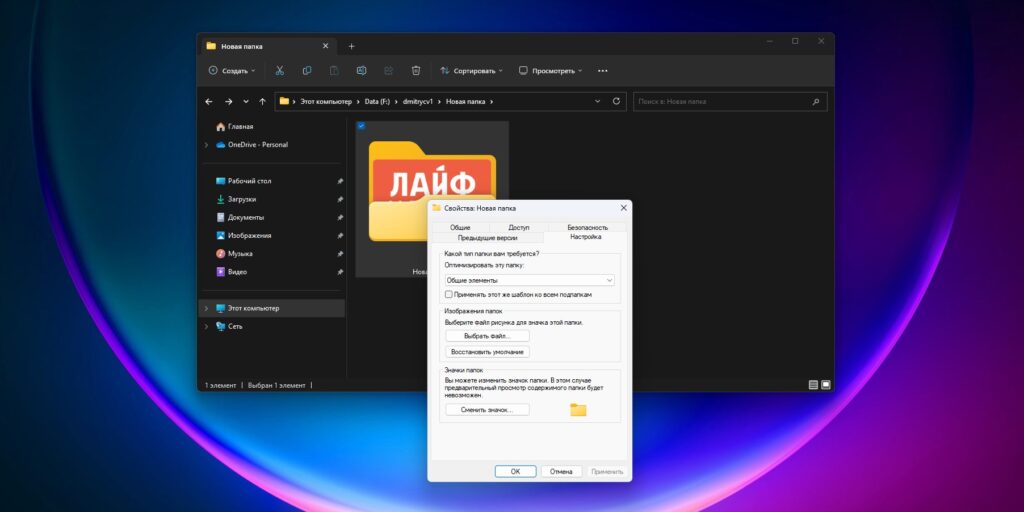
По умолчанию «Проводник» выбирает в качестве изображения для иконки папки первую картинку, которая в ней лежит. Но вам может захотеться изменить её. Для этого щёлкните правой кнопкой мыши по папке, которую вы хотите изменить, затем выберите опцию «Свойства». В открывшемся окне перейдите на вкладку «Настройка» и найдите раздел «Изображения папки». Там вы увидите кнопку «Выбрать файл».
Щёлкните по этой кнопке и найдите изображение, которое вам нужно — при этом оно не обязательно должно лежать в той папке, которую вы редактируете. Нажмите «Открыть». После выбора изображения нажмите «OK», чтобы закрыть окно свойств и применить изменения.
Теперь выбранное изображение будет использоваться в качестве новой миниатюры для папки.
10. Замена значка папки
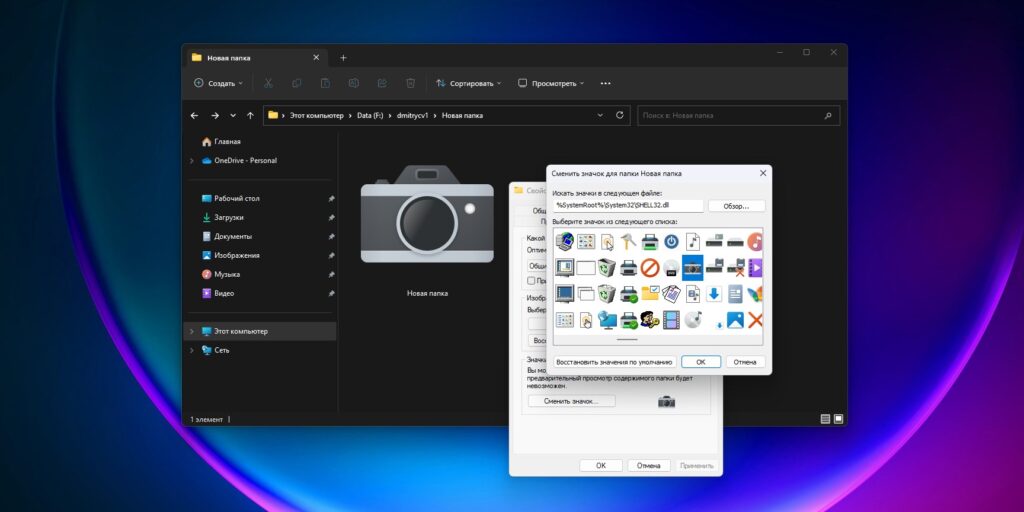
Аналогичным образом можно заменить значок папки. Щёлкните по ней правой кнопкой мыши и выберите «Свойства» из контекстного меню. В открывшемся окне перейдите на вкладку «Настройка» и нажмите на кнопку «Сменить значок».
Далее вы сможете остановиться на предлагаемых системой иконках либо нажать на кнопку «Обзор» и выбрать собственное изображение, которое будет использоваться в качестве значка папки. Во втором случае убедитесь, что оно имеет расширение .ico (формат иконок).
Либо после нажатия на кнопку «Обзор» вы можете указать EXE‑файл или ярлык любой установленной у вас программы. Так для папки вы сможете выбрать значок этого приложения.
После выбора желаемого значка нажмите «OK» во всех открытых окнах, чтобы применить изменения.
11. Использование опции «Поделиться»
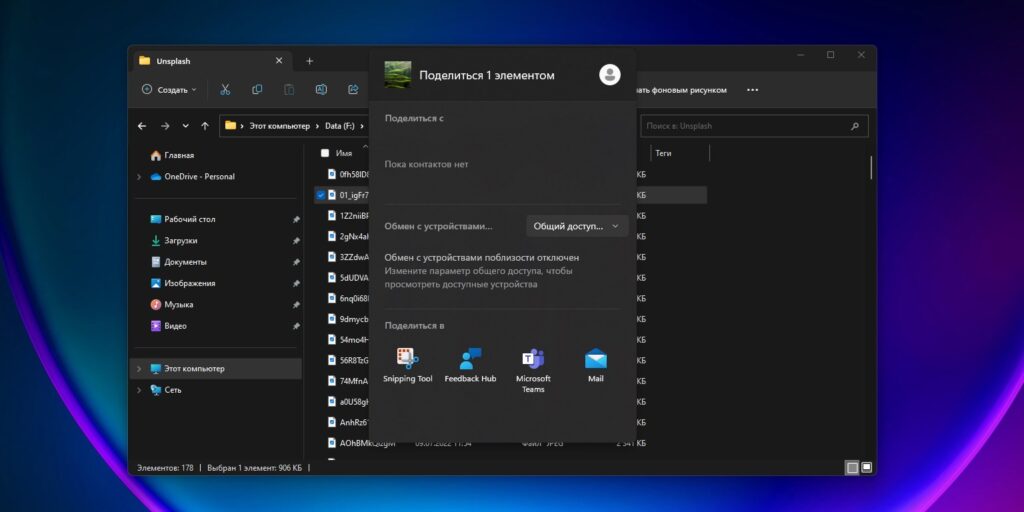
В Windows 11 Microsoft упростила процесс обмена файлами прямо из «Проводника». Щёлкните правой кнопкой мыши по любому файлу, который вы хотите отправить, и выберите опцию «Поделиться», расположенную в верхней части контекстного меню. После этого появятся варианты для обмена документом с ближайшими устройствами, вашими контактами или через подходящее приложение.
12. Замена стартовой папки
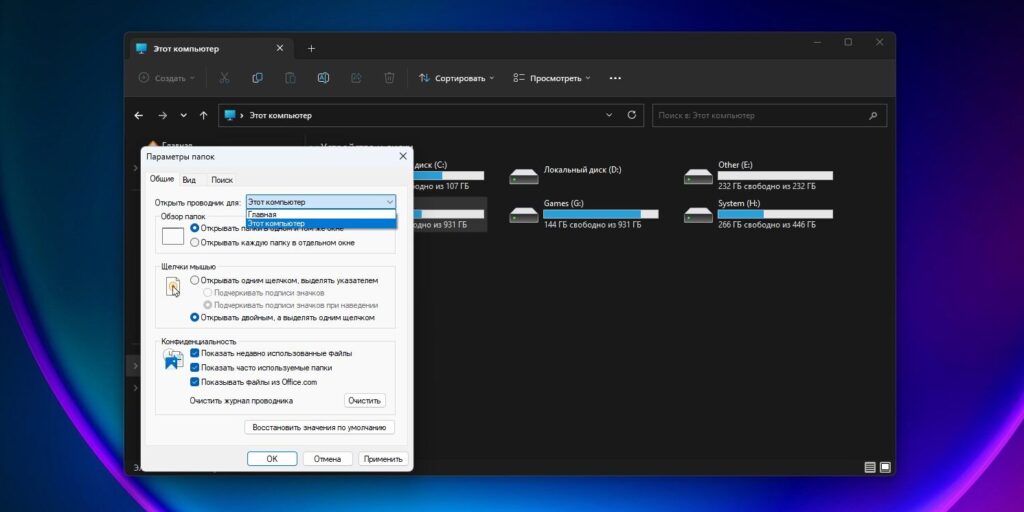
По умолчанию «Проводник» при запуске показывает «Быстрый доступ». Это может быть не очень удобно, если вы предпочитаете работать не со стандартными папками Windows 11, а с дисками. Но стартовый каталог можно легко заменить на «Этот компьютер».
Для этого в верхнем меню «Проводника» нажмите на иконку с тремя точками. В раскрывающемся меню выберите «Параметры». В появившемся окне найдите раздел «Открыть проводник для» и в раскрывающемся списке выберите «Этот компьютер». Нажмите ОК, чтобы сохранить изменения.
Теперь каждый раз, когда вы открываете «Проводник», он будет автоматически открывать раздел «Этот компьютер» вместо «Быстрого доступа».
File Explorer is one of the best features in the Windows operating system. If you’re a Windows user, you’ll end up using it to view what’s on your hard drive, open all your software, and manage your files. Therefore, File Explorer is one of the Windows 11 apps you really can’t do without.
Microsoft has given File Explorer a new look in Windows 11. It still retains all its customization options, but how you access them has changed slightly. These are the various ways you can customize Explorer with those options.
Change File and Folder Icon Sizes
Windows 11’s File Explorer app includes all the same view options it did before, along with one new one. Those view options enable you to choose different icon sizes for folders and files displayed in Explorer. You can also select different layouts for viewing folders’ contents.
To change the icon sizes, click the File Explorer taskbar button. Then click the View button on Explorer’s new command bar to bring up the menu shown directly below. There you can select extra-large, large, medium-sized, and small icon options.
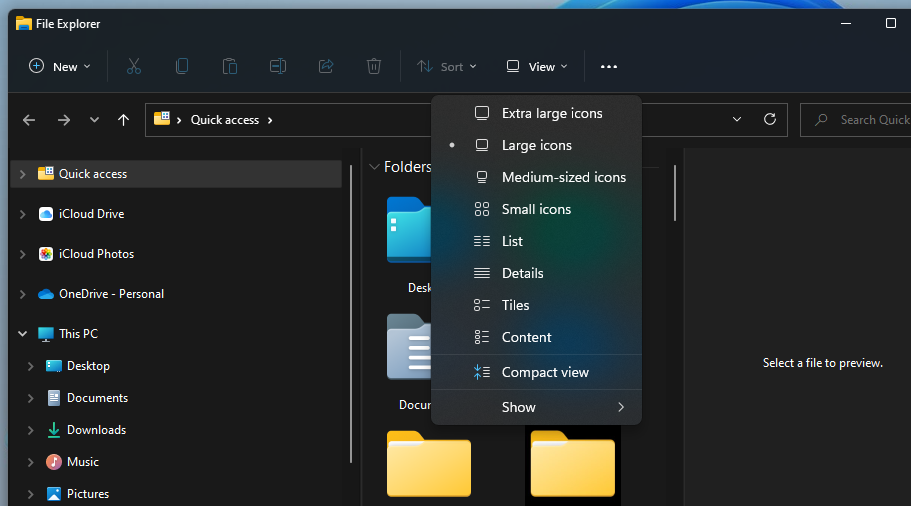
There are four layout options just below those icon size settings. You can select to view files with alternative list, detail, tile, or content layouts in Explorer. The List and Details options display additional date modified and size information for folders and files.
Compact view is the new File Explorer customization you can also select on that menu. That option removes the additional visual element padding added to Explorer in Windows 11. Selecting it makes the left panel’s folder navigation more compact as in the snapshot directly below.
Show or Hide Panes, Item Check Boxes, and File Extensions
The View menu includes an additional Show submenu. Select Show on that menu to reach the options in the snapshot directly below. Clicking Navigation, Details, and Pane options there will show or hide those Explorer features.
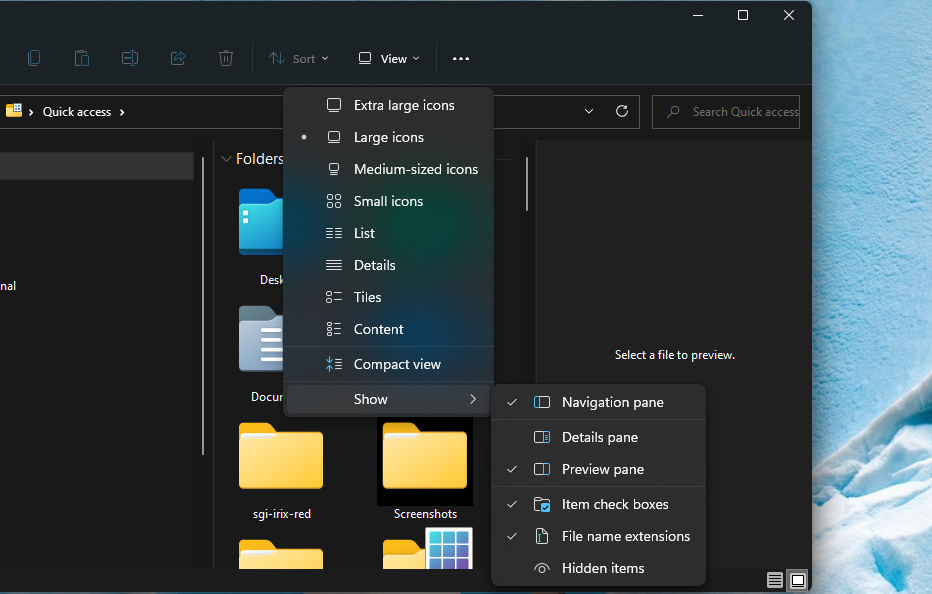
There are three other noteworthy customization settings below the pane options. Selecting the Item check boxes option will display small checkboxes beside selected folders and files. If you select File Name options, Explorer will include extensions for identifying formats at the end of all files. The Hidden Items option there shows all files and folders marked as hidden.
Change Folders’ Icons
There isn’t much variation in Explorer’s default folder icon scheme. However, you can customize folders by changing their icons. Adding new icons to your most important folders will make them more identifiable. This is how you can change folder icons in Explorer.
- Right-click a folder in Explorer and select Properties.
-
Then select the Customize tab shown directly below.
- Press the Change Icon button.
-
Choose an alternative icon for the folder from the System32 folder.
- Click the OK option.
- Select Apply on the properties window.
If you want to look for new File Explorer folder icons beyond the System32 folder, check out the IconArchive website. That site includes a multitude of visually appealing icons you can freely download and add to your folders. Enter the keyword folders in the IconArchive search box to find some new icons. To download one from there, select it and click the ICO button.
When you’ve downloaded some new icons, you can add them to your Explorer folders as outlined above. However, you’ll need to click Browse on the Change Icon window. Then select the downloaded icon from a different folder, and press the Open button.
Change Advanced Settings for Files and Folders
Explorer’s Folder Options window includes many advanced settings for folders and files. From that window’s View tab, you can configure how Explorer displays files and folders in greater detail. This is how you can change the way Explorer displays files and folders via Folder Options.
-
Click Explorer’s See more button (with three dots) to open the menu in the screenshot directly below.
- Select Options on that menu.
-
Then click the View tab shown directly below there.
- Select or deselect the advanced settings there to configure how Explorer displays files and folders.
- Press the Apply button to save your new settings.
To get a better idea of how those advanced options change the way Explorer displays folders and files, experiment a bit by selecting and deselecting them. Then have a look through Explorer to see the effects. You can always restore the default configuration by clicking the Restore Defaults button.
Enable Single-Click For Opening Files and Folders
By default, Explorer is configured to open items when you double-click them. However, you can change that by selecting a Single-click to open an item option. Then Explorer will open files and folders when you single-click them instead. This is how you can enable single-click for opening items.
- Open Folder Options by clicking the See more button and Options in Explorer.
-
Select the Single-click to open an item radio button on the General tab.
- Then select either the Underline icon titles consistent with my browser or Underline icon titles only when I point at them option.
- Click Apply to save the new settings.
- Select OK to close Folder Options.
Customize File Explorer With Winaero Tweaker
If you want more File Explorer customization options, check out the freeware Winaero Tweaker. That’s an advanced customization program with which you can further tweak File Explorer to your liking. You can download and install Winaero in the following steps.
- Open the Winaero Tweaker website.
- Click the Download Winaero Tweaker option on that site to save the program’s ZIP archive.
- Bring up File Explorer’s window.
- Open the Winaero ZIP archive you just downloaded.
-
Click the Extract all option on Explorer’s command bar.
-
Select the checkbox for the Show extracted files when complete option.
- Click Extract to finish.
- Then double-click WinaeroTweaker-1.33.0.0-setup.exe in its extracted folder.
- Go through the setup wizard to install the Winaero Tweaker.
- Open the Winaero Tweaker software.
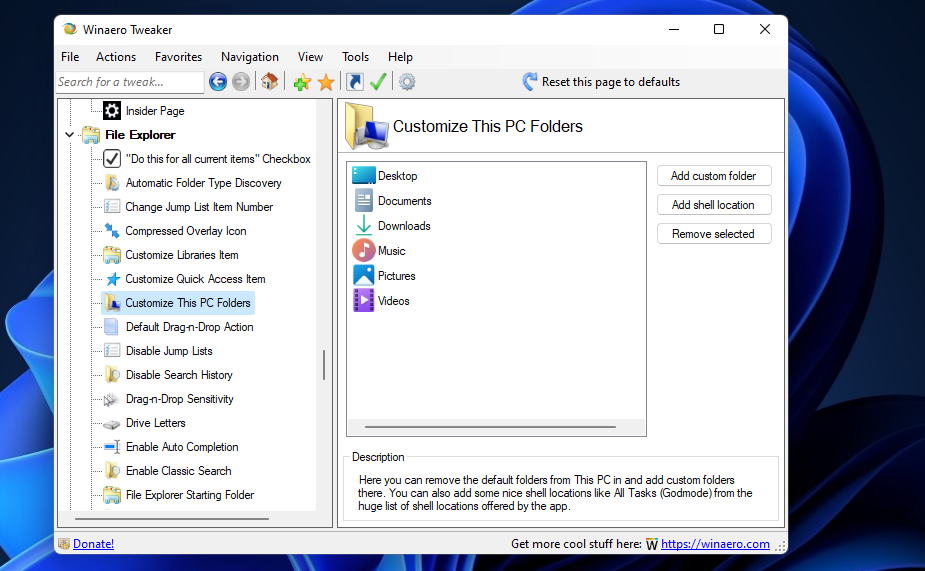
The File Explorer section of Winaero Tweaker includes 21 customization settings. Double-click File Explorer on the left side of the window to view its options. Winaero Tweaker includes full descriptions of what all those options do. These are some of its more notable customization settings or Explorer:
- Navigation Pane – Custom Items: A setting for adding Control Panel applets, system locations, or user folders to the navigation pane.
- Navigation Pane – Default Items: This option enables you to selectively remove default items from Explorer’s navigation pane.
- Customize This PC Folder: You can add custom icons to This PC folders with this setting.
- Customize Quick Access Item: This setting enables you to add a new icon to the Quick Access item and rename it.
- Customize Libraries Item: Select this option to change the Libraries item’s icon and rename it.
You can also restore the ribbon tabs from the old File Explorer with Winaero Tweaker. To do so, double-click the Windows 11 category and select Enable Ribbon in Winaero. Click the Enable the Ribbon UI in File Explorer checkbox. Then press the Restart Explorer button to apply.
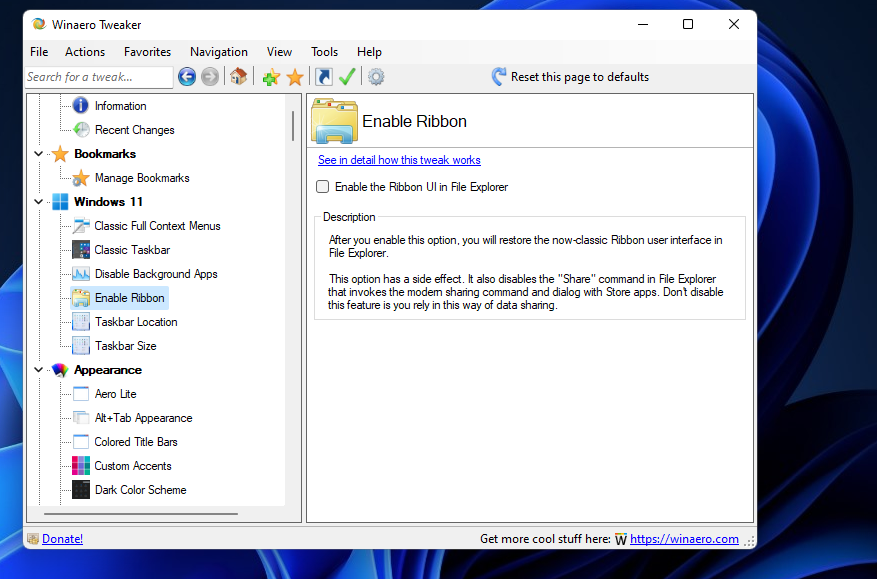
Now you’ll see the old View, Share, File, and Home tabs in File Explorer. You can select Explorer’s aforementioned customization options on the View tab. Press the Options button there to open the Folder Options window.
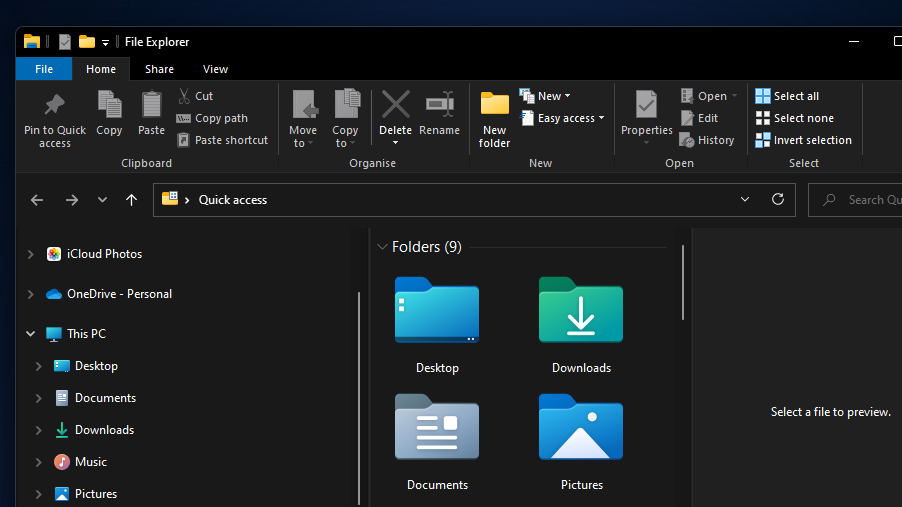
Configure File Explorer to Suit Your Preferences
So, there are many ways you can customize File Explorer with its built-in options and third-party software. With Explorer’s built-in customization settings, you can reconfigure how it displays files and folders. Winaero Tweaker’s additional settings are also a good extension to Explorer’s built-in options. You can make Explorer better suit your preferences with all those customization options.

